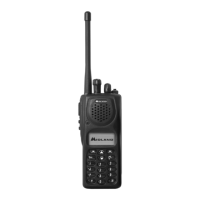SYN-TECH III P25 PORTABLE RADIO
SERVICE MANUAL
3-5
The MCU communicates with DSP by means of the HPI-8 address and data registers. The HPI-8 data
register in the DSP, includes bits controlling communication protocol. The HPI-8 communication
substructure does not run when DSP is in reset mode. Unless the DSP clock is activated, it remains in the
reset mode. The HPI-8 starts to operate when DSP exits reset mode. The HPI-8 accesses of MCU are
synchronous with the DSP clock signal. If the DSP and MCU attempt to access the same address, access
by the MCU has priority, and the DSP waits for one clock cycle.
Data communication on HPI-8 interface is made through 8-bit data bus (HD0-7). A1 and A2 control
signals select which register of HPI-8 will be accessed. Since the DSP has 16-bit structure, all HPI-8
accesses should be in two bytes. The MCU indicates whether it transfers first or second byte with the A0
signal.
The DSP-MCU communication has two main functions; to load (boot) the DSP when turned on and to
provide messaging during running. These functions are explained below.
In order to run a program on DSP, the program must be loaded to the DSP’s RAM. This process is called
booting the DSP. The “bootloader” program is located in DSP ROM. After reset the program transfers the
DSP code, from a source other than itself, to program memory of the DSP. The DSP boot process in the
radio is made through the HPI.
When the DSP sends a message, it writes the message code, message length and message content
onto “HPI_BUFFER” area and interrupts MCU via DSP_MC-IRQ line. The MCU reads the message from
the address specified when it receives the “interrupt” from the DSP_MC_IRQ output of the DSP.
3.2.3.2
UDSP – Baseband Modem A/D – D/A Converter Circuits
The C4FM signal used in digital modulation is generated by IC2. This integrated circuit is an A/D–D/A
converter using sigma–delta modulation method. Operating clock frequency is 12.288MHz.
Communication with DSP is made through the first synchronous serial port. The synchronous serial port
clock frequency is 6.144MHz. The required clock signal is genereated by IC2.
Digital data, which is coming from the DSP consisting of 16 bit data sampled at 48kHz, is converted into
analog in transmit mode. So, the C4FM baseband signal is obtained. Bit rate is 9600 bps and 10 times
over-sampling is used.
In receive mode, the baseband signal coming from RF and Control board is transferred to IC2 through J1
and digitally sampled at 48kHz with 16 bit resolution by IC2 is sent to the DSP through the serial port.
When the DSP is in idle mode, IC2 is kept at reset to consume less power. It is taken out of reset mode
through programming by means of the synchronous serial port for receive/transmit mode.
IC2 is operating as A/D converter (receive mode) or D/A converter (transmit mode) in radio units.
3.2.3.3
UDSP – Audio A/D – D/A Converter Circuits
The DSP communicates with audio band A/D–D/A Converter IC3 through a second serial port. IC3
synchronous serial port frequency is 2.048MHz and it is obtained by dividing 12.288MHz operating clock
signal by six with internal divider within IC3. Sampling frequency is 8kHz, resolution is 16 bit and linear
quantization is used.
IC3 samples the audio signal coming from MIC_BUFFER_AUDIO line in control board, in transmit mode
and sends the audio data to the DSP for digital processing. In receive mode, it sends the processed audio
data, which is coming from the DSP to control board through DIG_RX_AUDIO line by converting them
into analog signals. When not required, IC3 is left at reset mode to consume less power.
In these radios, IC3 is operated in receive and transmit modes.
3.2.3.4
UPower Circuits (IC4, IC5, IC6)
Step down converter, IC5, is adjusted so as to obtain the 3V3 DC voltage from DC power input coming at
4.5–24V interval which changes for different type of radios. The 3V3 signal is input to IC4 and IC6 linear
regulator integrated circuits. The 2.5V which IC2 and IC3 A/D–D/A converter integrated circuits require, is
obtained from IC4. The 1.5V core voltage of the DSP, is obtained from IC6.

